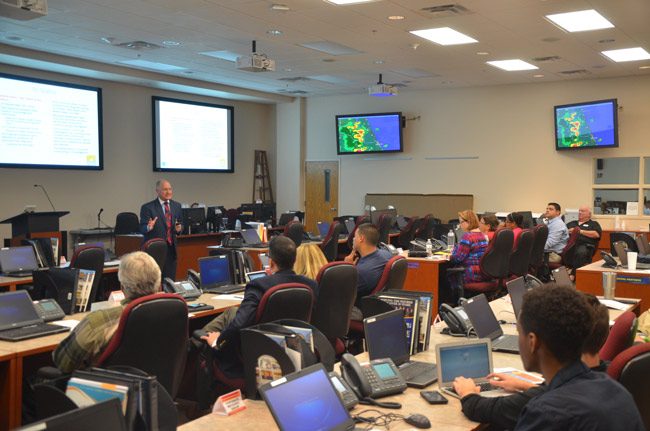
A mosquito buzz is increasingly sounding like a synonym for Zika. It isn’t: the chances of contracting Zika from a mosquito bite in Flagler County are next to nil for now, and the chances that Flagler County residents will contract it by traveling in Zika infested regions are not much greater, judging from current numbers. But government officials aren’t taking chances. Nor would they be allowed to take chances.
Now that Flagler County joined 35 other counties with incidences of Zika virus, the local health department and various governments have been following state orders to take uniform steps to contain the virus and educate residents about what they can do individually to prevent its spread. One of those orders was for the health department to collect representatives from every local government for a state-of-Zika overview and to solicit ideas about how best to confront the issue.
That meeting, led by Health Department Administrator Robert Snyder, took place this afternoon at Flagler County’s Emergency Operations Center, with officials from Palm Coast, Bunnell, the county and the mosquito control district in attendance. There were notable absences from Flagler Beach and the school board, even though state officials have emphasized schools’ role in amplifying awareness about the disease.
“We’re hoping everyone in here is going to be an ally in this battle,” Snyder said.
The order adding Flagler to the state emergency followed the finding on Sept. 19 that two Palm Coast residents had contracted the diseases after returning from Nicaragua. The state health department won’t say who they are or where they live. They joined the 700 known Zika cases contracted by Floridians, and the 3,625 cases nationwide.
As of today, the Centers for Disease Control was reporting 59 cases of Zika acquired from mosquito bites in the United States proper, all of them in two small areas of South Florida—a 1-square-mile area of the Wynwood neighborhood in Miami, and a 4.5-square mile area of Miami Beach, stretching from 8th to 63rd Street on the barrier island. The Wynnwood emergency has been lifted. In other words, the mosquito control response was effective there. Not so the Miami Beach emergency, which continues, though pregnant women and their partners (30 cases in the United States have been acquired through sex) are advised to avoid Miami Dade generally. Some 92 pregnant women with possible Zika infection are being monitored.
Two cases of Zika in Palm Coast trigger a response balancing alertness with pragmatism.
Puerto Rico, a frequent travel destination for Floridians, is reporting 21,535 cases of locally acquired Zika. Other than the United States, every country south of the Rio Grande with the exception of Chile and Uruguay, and every country in the Caribbean, has reported locally acquired Zika infections.
For most adults the disease is little more than an uncomfortable illness, if they feel it at all. Many won’t have symptoms even when infected. Others will feel feverish, have a rash, pain in the joints or in the muscles, or get headaches. But if pregnant women are infected, the virus they transmit to their fetus may provoke serious birth defects. And all Zika-infected patients “are advised to avoid mosquito bites while they are symptomatic by wearing long clothing, using repellant and staying indoors,” Sarah Revell, a spokesperson for the Florida Health Department, says. (Read how Zika is tested for here.)
Mosquitoes are an inevitable part of life in Florida. That’s why the East Flagler Mosquito Control District collects $1.7 million in local property tax revenue and is spending $360,000 of that on chemicals it sprays in Palm Coast and the rest of the eastern portion of the county to kill or control mosquitoes. For individual residents, the best way to control them—a message officials emphasized again today—is to restrict their breeding zones. Water is their nursery: it’s where they drop their eggs. So they thrive around standing water—even the standing water in your children’s forgotten toys outside, or that cooler you left out after a party, plant pots that quit draining in 1997, clogged gutters, bird baths or other or places in your yard that just drain poorly.
All the capabilities Miami Dade placed at the disposal of the mosquito control operation there are available here, should a similar emergency arise, Mark Positano, assistant director of the Flagler mosquito control district, said. And when residents report an infestation, the district quickly sends out a suppression response (basically, targeted spraying). But residents can be the first line of defense.
“I guess the big question is what more can we do,” Snyder said, putting it to the assembled officials. There were a few suggestions for “outreach”—placing public service announcements on various government websites, distributing documentation and mosquito-control-issued door hangers to the public library and social clubs, disseminating press releases. Curiously, not a single official mentioned the most effective source of local information: media outlets, compared to which much fewer people regularly navigate government websites unless they’re seeking something specific.

(© FlaglerLive)
Project Pandemic Prevention, as they’re calling their plan, is to find “natural ways to deter Zika in Flagler County, without pesticides,” Carll said.
“What we plan to do is to build houses to attract populations of bats to the houses, which they in turn eat up to 3,000 mosquitoes a night,” Dwyer said.
They’ll be developing their own public service announcements in conjunction with the project which, they hope, will have a direct impact on the local Zika campaign. As they spoke of it, Heather Wilson, a 2007 Community Problem Solver and international champion that year for her Natural Resource Growth energy-saving project, approached them and suggested from experience that they prepare their PSAs in multiple languages, to improve their chances at winning state and international competition. Wilson is now a mitigation planner at Flagler County Emergency Management.
The “houses” would be miniature wooden structures about six or seven feet long, a couple of feet high (four of those structures have been installed on roof rims at Flagler Palm Coast High School already), easily built and positioned at far ends of backyards. Carll and Dwyer would like to have about 20 of those bat houses spread around city and county, if they can recruit volunteers to host them. They’ve already attracted the attention of local officials—Snyder introduced them to the officials at today’s meeting, brimming with pride. “It’s fascinating,” he said of the project. “We loved it.”






























r&r says
Good proactive move.
Aynne McAvoy says
While I had to miss that meeting I had really hoped to get to, I am SO proud of these kids, they rocked it! I’ve been talking about adding bat houses to our county for FOUR YEARS! I have found a local woman who will build them for our county..in fact she is going to have one on display at the Bunnell Feed Store (ask JEFF if you inquire about it)….She just made mine and mine is going up hopefully this week. YAY!! I am a candidate for mosquito control seat three, and have been encouraging the use of bat houses for four years!
Rose Dwyer says
I am so proud of the brilliance of Jayson and Aaron. Their project is refreshing and brilliant. I truly hope their project gets noticed and funded.
Ana Vasquez says
Smart kids! Maybe our planet has a chance after all. Hope Flagler County listens and implements this great idea.
daveT says
What I find interesting is that the Zika virus disease first emerged 50 years ago in monkeys found in Uganda’s Zika forest. The first human cases of the mosquito-borne disease were reported in 1952. So in 2016 its become a world problem. Hum